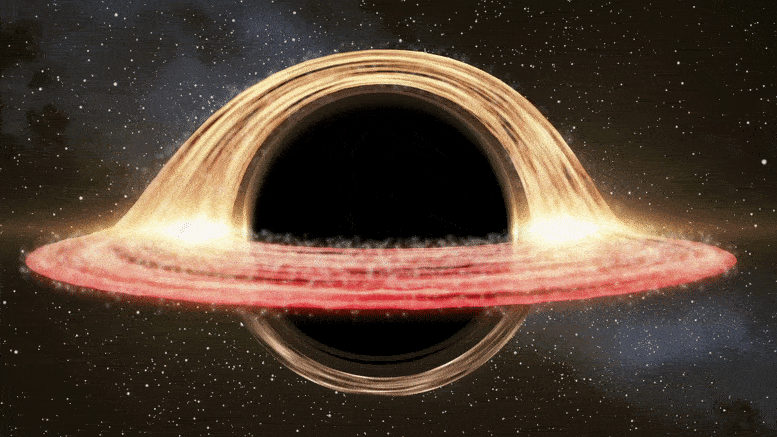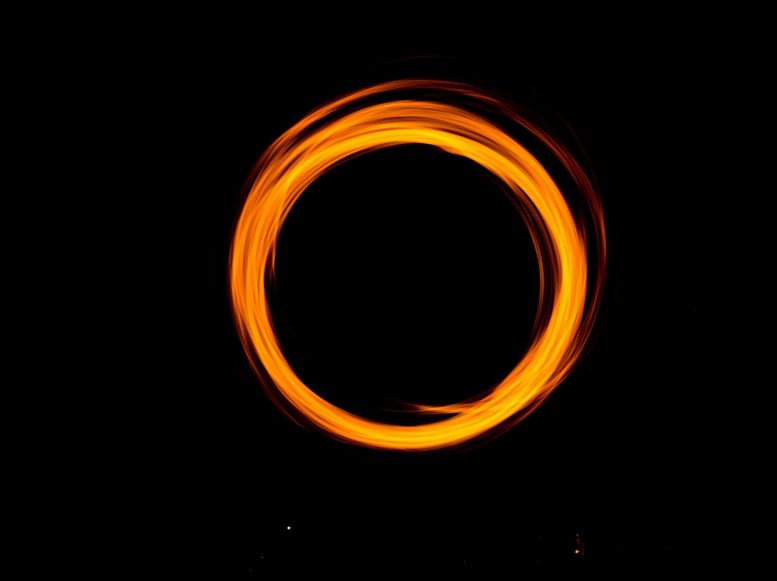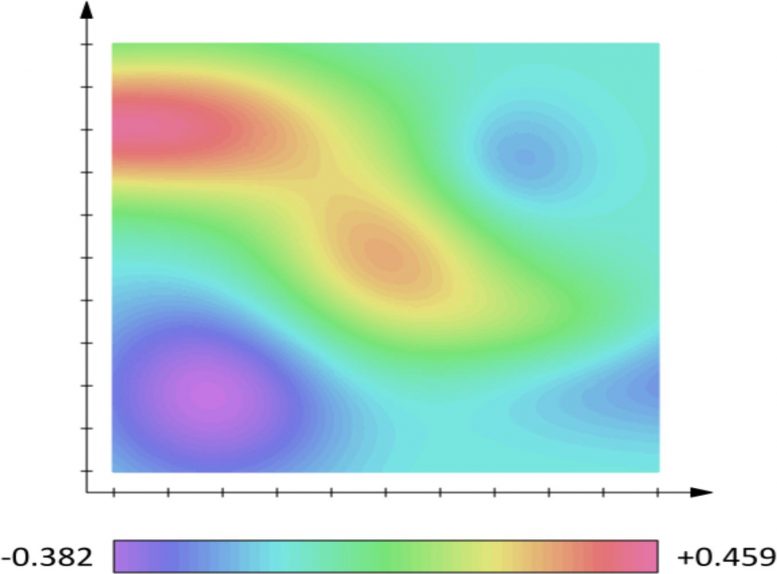
Artist’s illustration of Black Hole.
Although general relativity is a profoundly complex mathematical theory, its description of black holes is incredibly simple. A stable black hole can be described by just three properties: its mass, its electric charge, and its rotation or spin. Since black holes aren’t likely to have much charge, it really takes just two properties. If you know a black hole’s mass and spin, you know all there is to know about the black hole.
This property is often summarized by the no-hair theorem. Specifically, the theorem asserts that once matter falls into a black hole, the only characteristic that remains is mass. You could make a black hole out of a Sun’s worth of hydrogen, chairs, or those old copies of National Geographic from Grandma’s attic, and there would be no difference. Mass is mass as far as general relativity is concerned. In every case the event horizon of a black hole is perfectly smooth, with no extra features. As Jacob Bekenstein said, black holes have no hair.

The conflict between relativity and quantum theory leads to the firewall paradox. Credit: Jeremy Perkins / Unsplash
But with all its predictive power, general relativity has a problem with quantum theory. This is particularly true with black holes. If the no-hair theorem is correct, the information held within an object is destroyed when it crosses the event horizon. Quantum theory says that information can never be destroyed. So the valid theory of gravity is contradicted by the valid theory of the quanta. This leads to problems such as the firewall paradox, which can’t decide whether an event horizon should be hot or cold.
Several theories have been proposed to solve this contradiction, often involving extensions to relativity. But the difference between standard relativity and these modified theories can only be seen in extreme situations, making them difficult to study observationally. But a paper in Physical Review Letters shows how they might be studied through the spin of a black hole.
Many modified relativity theories have an extra parameter not seen in the standard theory. Known as a massless scalar field, it allows Einstein’s model to connect with quantum theory in a way that isn’t contradictory. In this new work, the team looked at how such a scalar field connects to the rotation of a black hole. They found that at low spins, a modified black hole is indistinguishable from the standard model, but at high rotations the scalar field allows a black hole to have extra features. In other words, in these alternative models, rapidly rotating black holes can have hair.
The hairy aspects of rotating black holes would only be seen near the event horizon itself, but they would also affect merging black holes. As the authors point out, future gravitational wave observatories should be able to use rapidly rotating black holes to determine whether an alternative to general relativity is valid.
Einstein’s theory of general relativity has passed every observational challenge so far, but it will likely break down in the most extreme environments of the universe. Studies such as this show how we might be able to discover the theory that comes next.
Reference: “Spin-Induced Black Hole Spontaneous Scalarization” by Alexandru Dima, Enrico Barausse, Nicola Franchini and Thomas P. Sotiriou, 1 December 2020, Physical Review Letters.
DOI: 10.1103/PhysRevLett.125.231101
Adapted from an article originally published on Universe Today.










Here again frankly the supposition is made that black holes can not destroy data because it contradicts quantum theory based on the fact that its equations are unitary and thus conservation is demanded therefrom. But to assume that so is not science, rather it must be proved that information is not conserved for black holes or not. That is probably not possible to prove and the absence of proof does not verify anything. Additionally the interior of a black hole may indeed break all physics including quantum physics not just GR. But black hole interiors may never be observable and therefore confirmation impossible. We may never know but the assumption of an entropic firewall is just nutty speculation and very likely not provable so efforts there are probably going to be in vain. Even Hawking radiation contains no information because everything emitted is completely randomized. Its quite possible we will never know what goes on inside a black hole and unprovable guesses don’t really accomplish anything. Better to focus on understanding the event horizon and glean what we can from gravitational waves both of which are observable, however such waves do not originate from the interior of a black hole, rather for gravity waves from space time from the mere presence of black hole masses in motion and for the event horizon from plasma out side the black holes gravitational jail. Neither still do not broadcast any information about the interior.
… I guess, some things will become more important under some conditions, that we don’t see each day, it was similar to Newtons theory, it was okay till it wasn’t… but with Albert’s one is more like, do have a better candidate, … no, well then it is still okay, …
is this Marvel or something?
Door #1#2infinity🌑👍 🌚all good 😃 🙂 smile
From the perspective of matter falling toward a stable event horizon, the last millimeters of the fall take an infinite amount of time. Of course, most event horizons are expanding and so they push outward past the falling matter.
While it is useful to model a black hole as a mass with spin from the outside, it is interesting to follow the matter “inside” after the event horizon engulfs it. If time’s arrow reverses inside the event horizon does gravity become repulsive? If so , the matter is still stuck inside forever, but it starts approaching the event horizon on an infinitely slow trip from the inside.
Now, we may not yet have the ability to test this hypothesis, but if it is true the rotational inertia of a black hole will be that of a mass concentrated near the horizon, which is a bit more useful, information wise, than a rotating dimensionless point.
Oh Yeh! teories are nice, and many, but believe without confirmations by the observation is not cience.
If electromagnetic waves (light) and gravitational waves (change in mass/distance) propogate through timespace at the same rate, and time is so dilated that light cannot escape the event horizon, then how does gravity escape the event horizon, to supposedly attract more mass?
On earth, the strongest gravitation is at sea-level, and there is zero net gravitation “pull” at the center, i.e., freefall. If there is infinite mass and zero gravitational force at the center of a black hole, then what is the relative time?